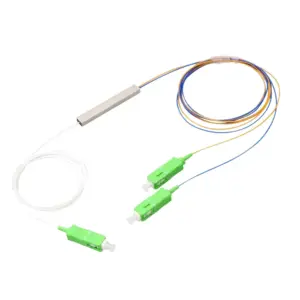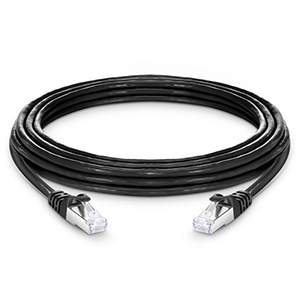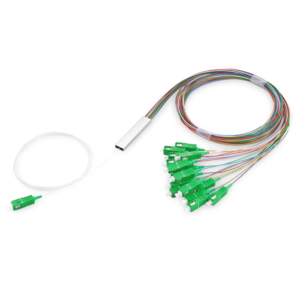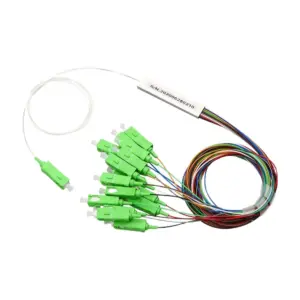DWDM (Dense Wavelength Division Multiplexing) technology plays a key role in high-speed optical networks. This article will explore the relevant knowledge of DWDM transceivers. We will first briefly introduce the working principle and advantages of DWDM and explain its application in optical fiber communications. Next, we will define the application of optical transceivers in DWDM networks and explain the key role of DWDM transceivers in DWDM systems.
Then, we will focus on the main characteristics of DWDM transceivers, including light source type, wavelength and channel spacing, optical power, optical multiplexing/demultiplexing, fiber connection, as well as power consumption and heat dissipation. We will analyze the impact of these characteristics on the performance of DWDM networks. Finally, we will introduce the typical deployment scenarios of DWDM transceivers in different networks and analyze its advantages in various application scenarios.
Overview of DWDM Technology
Working Principles and Advantages of DWDM:
DWDM (Dense Wavelength Division Multiplexing) is an advanced optical transmission technology. Its basic working principle is as follows:
At the transmitting end, multiple optical signals of different wavelengths are combined into the same optical fiber for transmission. The transmitting end uses an optical division multiplexer (MUX) to combine these optical signals into a beam of broadband light. This beam of broadband light is transmitted along the same optical fiber, taking advantage of the large bandwidth characteristics of the optical fiber. At the receiving end, the optical signal is separated into multiple independent optical signals of different wavelengths by an optical separator (DEMUX), and then subjected to photoelectric conversion.
This technology has the following main advantages:
(1) Bandwidth expansion: DWDM can transmit up to 80-100 optical signals on a single optical fiber, greatly expanding the transmission bandwidth of a single optical fiber.
(2) Extended transmission distance: The DWDM system uses optical amplifiers to achieve long-distance non-relay transmission, reducing network deployment costs.
(3) High spectrum utilization: DWDM uses dense wavelength spacing, effectively utilizing the spectrum resources of optical fibers and improving network resource utilization efficiency.
(4) High flexibility: DWDM is highly modular and scalable, and can be adjusted dynamically according to demand to meet the needs of different business development stages.
(5) High reliability: The DWDM system adopts multi-channel redundant transmission and uses optical amplifiers to provide hot backup functions, which greatly improves the reliability of the network.
Application of DWDM in optical fiber communication:
DWDM technology is one of the key technologies in current optical fiber communication networks and is widely used in the following scenarios:
(1) Trunk transmission network: DWDM can greatly improve the transmission bandwidth and distance of the trunk network, meeting the backbone network’s needs for high-capacity and long-distance transmission.
(2) Metropolitan/wide area network: DWDM’s high bandwidth and long-distance transmission characteristics are suitable for backbone transmission applications in metropolitan area networks and wide area networks.
(3) Data center interconnection: DWDM can efficiently realize large-capacity optical fiber interconnection between data centers to meet the needs of massive data transmission.
(4) Wireless mobile fronthaul: The high bandwidth characteristics of DWDM can provide high-speed and reliable fronthaul network support for new generation wireless networks such as 5G.
(5) Professional application network: DWDM is also widely used in high-bandwidth network requirements in professional fields such as medical care and education.
In short, DWDM technology has become one of the key technologies of current optical fiber communication networks with its excellent bandwidth expansion and long-distance transmission characteristics, and plays a key role in many application scenarios.
Definition and function of DWDM transceiver
Application of optical transceiver in DWDM network:
In DWDM (Dense Wavelength Division Multiplexing) network, optical transceiver is a key device. Its main functions are as follows:
(1) At the transmitting end, the optical transceiver is responsible for converting electrical signals into optical signals of different wavelengths.
(2) Multiplex these optical signals of different wavelengths onto the same optical fiber for transmission.
(3) At the receiving end, the optical transceiver separates the received broadband optical signal into independent optical signals.
(4) Finally, convert these optical signals back into electrical signals for output.
The optical-to-electrical conversion and wavelength division multiplexing/demultiplexing functions of the optical transceiver are the key to the DWDM network’s ability to transmit multiple independent optical signals on a single optical fiber.
The key role of DWDM transceivers in DWDM systems:
DWDM transceivers play the following key roles in DWDM transmission systems:
(1) Optical-to-electrical conversion: convert the electrical signals of the upper layer services into optical signals of different wavelengths and realize the reverse optical-to-electrical conversion.
(2) Wavelength division multiplexing/demultiplexing: use multiplexers (MUX) and demultiplexers (DEMUX) to multiplex or separate multiple optical signals.
(3) Wavelength selection: DWDM transceivers can select specific wavelengths for transmission according to demand.
(4) Signal modulation: DWDM transceivers use advanced modulation technologies, such as DPSK, QPSK, etc., to improve transmission performance.
(5) Signal monitoring: DWDM transceivers are equipped with functions such as optical power monitoring to ensure transmission quality.
In short, as the core equipment of the DWDM system, DWDM transceivers complete key functions such as optoelectronic conversion and wavelength division multiplexing/demultiplexing, and are the key to achieving DWDM high-bandwidth transmission. It is an important foundation for the widespread application of DWDM technology.
Main features of DWDM transceivers
The main features of DWDM transceivers include supporting multi-wavelength signal transmission, improving fiber utilization, and long-distance transmission capabilities. It can transmit multiple channels in parallel on a single optical fiber, and has the advantages of high bandwidth, high stability and low power consumption. It is widely used in long-distance and high-density optical fiber communication networks.
Light source type:
- Common light sources for DWDM transceivers include DFB (distributed feedback) lasers and externally modulated lasers.
- DFB lasers are small in size, low in power consumption and low in cost, but have narrow spectrum and poor wavelength stability.
- Externally modulated lasers have wide spectrum and high wavelength stability, but are large in size, high in power consumption and high in cost.
- Different light source types have a trade-off between DWDM performance, power consumption and cost.
Wavelength and channel spacing:
- The wavelength range used by DWDM transceivers is usually 1530-1565nm, and the channel spacing is 50GHz or 100GHz.
- Narrower channel spacing can accommodate more independent channels and increase the total bandwidth of a single optical fiber.
- However, too narrow spacing will increase the requirements for wavelength stability and optical filter performance.
Optical power:
- The optical output power of a DWDM transceiver is usually between 0-10dBm, which is a key parameter affecting the transmission distance.
- Higher optical power is conducive to overcoming the inherent attenuation loss of optical fiber and achieving a longer transmission distance.
- However, too high optical power may lead to nonlinear effects, and reasonable power balance must be performed.
Optical multiplexing/demultiplexing:
- DWDM transceivers use optical division multiplexers (MUX) and optical separators (DEMUX) to achieve multiplexing and demultiplexing of multiple optical signals.
- High-performance optical multiplexing/demultiplexing modules are the key to ensuring the quality and isolation of DWDM signals.
Fiber optic connection:
- DWDM transceivers usually use standard LC/SC fiber optic connectors to facilitate docking with fiber optic networks.
- Good fiber optic connection is the basis for ensuring transmission reliability and has an important impact on network deployment and maintenance.
Power consumption and heat dissipation:
- As an active device, DWDM transceivers have high power consumption and require effective heat dissipation design.
- Good power consumption and heat dissipation performance are conducive to improving the stability and reliability of the transceiver.
In short, these key features of DWDM transceivers determine their performance, cost and application applicability in DWDM systems. Targeted selection and configuration are required according to actual needs.
Typical application scenarios of DWDM transceivers
Typical application scenarios of DWDM transceivers include long-distance backbone network transmission, large data center interconnection, and urban fiber ring networks. It achieves efficient bandwidth utilization by transmitting multiple wavelengths on a single optical fiber, and is suitable for optical fiber communication environments that require large capacity and high reliability.
DWDM transceivers are the core equipment of DWDM technology and are widely used in the following typical network scenarios:
Trunk transmission network:
- DWDM transceivers play an important role in trunk transmission networks and can provide ultra-high bandwidth.
- The long-distance transmission capability of DWDM transceivers can realize long-distance relay-free transmission of trunk networks.
- Flexible wavelength selection function is conducive to dynamic bandwidth allocation and scheduling of trunk networks.
Metropolitan/wide area network:
- DWDM transceivers are suitable for deployment in the trunk and aggregation layers of metropolitan area networks and wide area networks.
- Its high bandwidth and long-distance transmission characteristics can meet the needs of metropolitan area networks and wide area networks for backbone networks.
- Modular design and scalability facilitate the gradual capacity expansion of metropolitan area networks and wide area networks.
Data center interconnection:
- DWDM transceivers have unique advantages in fiber-optic interconnection between data centers.
- Its ultra-high single-fiber transmission bandwidth can carry massive data center business traffic.
- Reliable transmission performance and intelligent optical path management ensure high-speed interconnection between data centers.
5G fronthaul network:
- DWDM transceivers play an important role in the fronthaul network of new generation mobile networks such as 5G.
- Its high bandwidth characteristics can support the large-capacity fronthaul transmission requirements between 5G base stations.
- Simple deployment and maintenance characteristics are conducive to the rapid deployment of 5G fronthaul networks.
Professional application network:
- DWDM transceivers are also widely used in high-speed networks in professional fields such as medical care and education.
- Its long-distance transmission and high reliability meet the stringent requirements of these applications for network performance.
- The modular design also facilitates the flexible deployment and expansion of professional networks.
In short, DWDM transceivers have become key supporting equipment for many high-speed optical transmission networks with their excellent bandwidth, distance and reliability, and play a key role in trunk transmission, metropolitan area networks, data centers, 5G fronthaul and other scenarios.
Summary
DWDM transceivers are key components for building high-performance DWDM networks. Our company has long focused on the research and development and application of DWDM technology and has rich practical experience. We provide various high-performance DWDM transceiver products, which are widely used in backbone networks, metropolitan area networks and other fields. Our DWDM transceivers adopt industry-leading technology and have achieved excellent levels in transmission performance, power consumption, reliability and other aspects.
At the same time, our engineering team will provide you with professional demand analysis and product selection services to ensure that the selected DWDM transceiver can meet your actual needs to the greatest extent. Contact us now to learn more. We will do our best to provide you with the best products and solutions.
DWDM Transceiver FAQ
A DWDM transceiver is a type of optical transceiver module that is used in Dense Wavelength Division Multiplexing systems to transmit and receive data over multiple wavelengths (channels) on a single optical fiber, enabling high-capacity and long-distance data transmission.
A DWDM transceiver converts electrical data signals into optical signals at specific wavelengths and transmits them over a fiber-optic cable. It also receives optical signals from the fiber and converts them back into electrical signals for processing.
DWDM transceivers are used in telecommunications networks, data centers, and enterprise networks to increase bandwidth by allowing multiple data channels to be transmitted simultaneously on a single optical fiber.
DWDM transceivers enable high data transfer rates, efficient use of fiber infrastructure, and the ability to carry multiple data streams simultaneously, which increases network capacity and reduces the need for additional fiber.
Unlike standard transceivers that operate on a single wavelength, DWDM transceivers can operate on multiple wavelengths in the DWDM spectrum, allowing for greater data capacity and more efficient use of fiber-optic infrastructure.
DWDM transceivers typically operate in the C-band (1530 nm to 1565 nm) and sometimes the L-band (1565 nm to 1625 nm) wavelength ranges, which are commonly used for long-haul and high-capacity networks.
Choosing the right DWDM transceiver depends on factors such as the desired data rate, distance, network architecture, and the specific DWDM channel or wavelength you need to use in your network.
A fixed-wavelength DWDM transceiver operates on a specific wavelength, while a tunable DWDM transceiver can be adjusted to operate on different wavelengths within the DWDM spectrum, offering greater flexibility and easier network management.
DWDM transceivers can support long-distance transmission, typically ranging from 40 km to over 100 km, depending on the transceiver type, network setup, and whether optical amplifiers are used.
DWDM transceivers are typically used with single-mode fiber due to the need for long-distance transmission and the narrow channel spacing in DWDM systems. They are not typically used with multi-mode fiber, which is more suitable for shorter distances.





